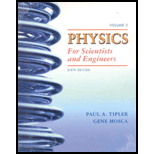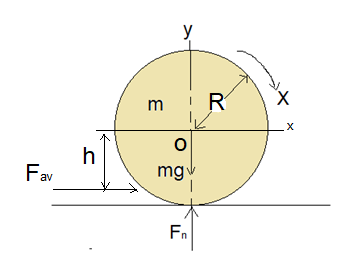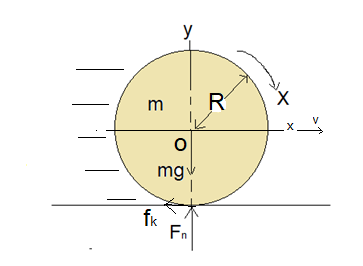
Concept explainers
(a)
The angular speed of the ball just after the blow.
(a)
Answer to Problem 106P
Explanation of Solution
Given: The horizontal force applied on a billiard ball at a distance
Speed of the ball just after the blow is
The coefficient of kinetic friction between the ball and billiard table is
Formula Used:
Newton’s second law of motion in rotational form
Calculation:

FIGURE: 1
Applying Newton’s second law in rotational form to ball,
Where,
Moment of inertia with respect to an axis through the center of mass of the ball is
Substituting this in equation
Applying impulse-momentum theorem to the ball,
Where,
From equation
Substituting the expression for
Substituting
Conclusion:
The angular speed of the ball just after the blow is
(b)
The speed of the ball once it begins to roll without slipping.
(b)
Answer to Problem 106P
Explanation of Solution
Given: Speed of the ball just after the blow is
The coefficient of kinetic friction between the ball and billiard table is
Formula Used:

FIGURE: 2
Referring to the force diagram shown in figure 2, applying Newton’s second law to the ball when it is rolling without slipping,
And
Where,
But,
Where,
Calculations:
From equation
Substituting this in equation
From equation
Moment of inertia with respect to an axis through the center of mass of the ball is
Substituting for
Now let us write constant-acceleration equation that connects angular speed of the ball to the angular acceleration and time,
Now,substituting the expression for
Constant acceleration equation that relates the speed of the ball to the acceleration and time,
Where,
Substituting for
Imposing the condition for rolling the ball without slipping,
Substituting this
Conclusion:
The speed of the ball once it begins to roll without slipping is
(c)
The kinetic energy of the ball just after the hit.
(c)
Answer to Problem 106P
Explanation of Solution
Given: The horizontal force applied on a billiard ball at a distance
Speed of the ball just after the blow is
The coefficient of kinetic friction between the ball and billiard table is
Formula Used:
Initial kinetic energy of the ball can be written as,
Where,
Substituting the expressions for
Where,
Moment of inertia,
Substituting these in equation
Conclusion:
The kinetic energy of the ball just after the hit is
Want to see more full solutions like this?
Chapter 9 Solutions
Physics for Scientists and Engineers, Vol. 3
- If the torque acting on a particle about an axis through a certain origin is zero, what can you say about its angular momentum about that axis?arrow_forwardA buzzard (m = 9.29 kg) is flying in circular motion with aspeed of 8.44 m/s while viewing its meal below. If the radius ofthe buzzards circular motion is 8.00 m, what is the angularmomentum of the buzzardaround the center of its motion?arrow_forwardA solid cylinder of mass 2.0 kg and radius 20 cm is rotating counterclockwise around a vertical axis through its center at 600 rev/min. A second solid cylinder of the same mass and radius is rotating clockwise around the same vertical axis at 900 rev/min. If the cylinders couple so that they rotate about the same vertical axis, what is the angular velocity of the combination?arrow_forward
- A wad of sticky clay with mass m and velocity vi is fired at a solid cylinder of mass M and radius R (Fig. P10.75). The cylinder is initially at rest and is mounted on a fixed horizontal axle that runs through its center of mass. The line of motion of the projectile is perpendicular to the axle and at a distance d R from the center. (a) Find the angular speed of the system just after the clay strikes and sticks to the surface of the cylinder. (b) Is the mechanical energy of the claycylinder system constant in this process? Explain your answer. (c) Is the momentum of the claycylinder system constant in this process? Explain your answer. Figure P10.75arrow_forwardThe position vector of a particle of mass 2.00 kg as a function of time is given by r=(6.00i+5.00tj), where r is in meters and t is in seconds. Determine the angular momentum of the particle about the origin as a function of time.arrow_forwardTwo astronauts (Fig. P10.67), each having a mass M, are connected by a rope of length d having negligible mass. They are isolated in space, orbiting their center of mass at speeds v. Treating the astronauts as particles, calculate (a) the magnitude of the angular momentum of the two-astronaut system and (b) the rotational energy of the system. By pulling on the rope, one of the astronauts shortens the distance between them to d/2. (c) What is the new angular momentum of the system? (d) What are the astronauts new speeds? (e) What is the new rotational energy of the system? (f) How much chemical potential energy in the body of the astronaut was converted to mechanical energy in the system when he shortened the rope? Figure P10.67 Problems 67 and 68.arrow_forward
- A uniform disk of mass m = 10.0 kg and radius r = 34.0 cm mounted on a frictionlessaxle through its center, and initially at rest, isacted upon by two tangential forces of equalmagnitude F, acting on opposite sides of itsrim until a point on the rim experiences acentripetal acceleration of 4.00 m/s2 (Fig.P13.73). a. What is the angular momentumof the disk at this time? b. If F = 2.00 N, howlong do the forces have to be applied to thedisk to achieve this centripetal acceleration? FIGURE P13.73arrow_forwardCan you assign an angular momentum to a particle without first defining a reference point?arrow_forwardIf a particle is moving with respect to a chosen origin it has linear momentum. What conditions must exist for this particle’s angular momentum to be zero about the chosen origin?arrow_forward
- Two astronauts (Fig. P10.67), each having a mass of 75.0 kg, are connected by a 10.0-m rope of negligible mass. They are isolated in space, orbiting their center of mass at speeds of 5.00 m/s. Treating the astronauts as particles, calculate (a) the magnitude of the angular momentum of the two-astronaut system and (b) the rotational energy of the system. By pulling on the rope, one astronaut shortens the distance between them to 5.00 m. (c) What is the new angular momentum of the system? (d) What are the astronauts new speeds? (e) What is the new rotational energy of the system? (f) How much chemical potential energy in the body of the astronaut was converted to mechanical energy in the system when he shortened the rope? Figure P10.67 Problems 67 and 68.arrow_forwardIf you know the velocity of a particle, can you say anything about the particle’s angular momentum?arrow_forwardThe oldest artificial satellite still in orbit is Vanguard I, launched March 3, 1958. It mass is 1.60 kg. Neglecting atmospheric drag, the satellite would still be in its initial orbit, with a minimum distance from the center of Earth of 7.02 Mm and a speed at this perigee point of 8.23 km/s. For this orbit, find (a) the total energy of the satelliteEarth system and (b) the magnitude of the angular momentum of the satellite. (c) At apogee, find the satellites speed and its distance from the center of the Earth. (d) Find the semimajor axis of its orbit. (e) Determine its period.arrow_forward
 Principles of Physics: A Calculus-Based TextPhysicsISBN:9781133104261Author:Raymond A. Serway, John W. JewettPublisher:Cengage Learning
Principles of Physics: A Calculus-Based TextPhysicsISBN:9781133104261Author:Raymond A. Serway, John W. JewettPublisher:Cengage Learning Physics for Scientists and Engineers, Technology ...PhysicsISBN:9781305116399Author:Raymond A. Serway, John W. JewettPublisher:Cengage Learning
Physics for Scientists and Engineers, Technology ...PhysicsISBN:9781305116399Author:Raymond A. Serway, John W. JewettPublisher:Cengage Learning Physics for Scientists and Engineers with Modern ...PhysicsISBN:9781337553292Author:Raymond A. Serway, John W. JewettPublisher:Cengage Learning
Physics for Scientists and Engineers with Modern ...PhysicsISBN:9781337553292Author:Raymond A. Serway, John W. JewettPublisher:Cengage Learning Physics for Scientists and EngineersPhysicsISBN:9781337553278Author:Raymond A. Serway, John W. JewettPublisher:Cengage Learning
Physics for Scientists and EngineersPhysicsISBN:9781337553278Author:Raymond A. Serway, John W. JewettPublisher:Cengage Learning University Physics Volume 1PhysicsISBN:9781938168277Author:William Moebs, Samuel J. Ling, Jeff SannyPublisher:OpenStax - Rice University
University Physics Volume 1PhysicsISBN:9781938168277Author:William Moebs, Samuel J. Ling, Jeff SannyPublisher:OpenStax - Rice University Physics for Scientists and Engineers: Foundations...PhysicsISBN:9781133939146Author:Katz, Debora M.Publisher:Cengage Learning
Physics for Scientists and Engineers: Foundations...PhysicsISBN:9781133939146Author:Katz, Debora M.Publisher:Cengage Learning





